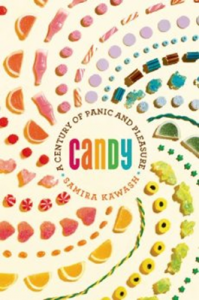While the government is shut down, have some fun. Read (not eat) “Candy”
Samira Kawash. Candy: A Century of Panic and Pleasure. Faber & Faber, 2013.
In this delightful, intriguing account of candy in the United States, Samira Kawash argues that we must stop vilifying this sugary treat and start taking it more seriously—as a cultural icon, a marker of gender identity, a prototype of the marketing of processed foods, a source of pleasure for children and adults, and for good or ill, a contributor to daily diets.
Candy, she correctly points out, is not all that different from many other sugar-laden foods and deserves its rightful place in American diets—in moderation, of course.
Kawash, who writes the candy professor blog, wanted to call this book “In Defense of Candy,” which is what it is. I loved her writing, her originality, and her sense of humor. For example, she makes the connection between views of “sweet, trivial people (women and children) and sweet, trivial candy” and observes that “So much of what we call food today is really candy.”
And so it is.




